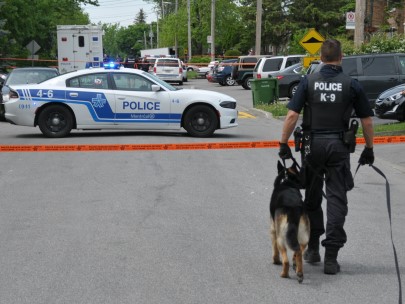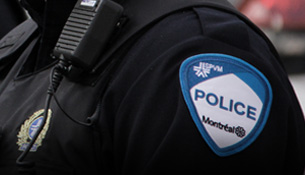Canine Unit

Description of the unit
The SPVM canine unit is made up of:
- 15 dog handlers
- 13 operational dogs currently
The unit may count on the services of 13 dog and handler teams.
Dogs from the canine unit specialize in specific types of work:
- Each dog has general purpose training (building search, tracking, manhunt, etc.) and a specialization in narcotics detection or explosives detection.
Roles and responsibilities
The canine unit supports the SPVM officers in their investigations and daily activities. It is also called upon to work in certain operations where its specialties are required.
For example, the unit will cooperate with police forces in Québec that do not have a canine unit or work with the dog handlers in other police forces during major events and it will participate in media, community and cultural events (in schools, community meetings or television shows) to promote the canine unit and the SPVM.
The dogs in the canine unit are trained to intervene in a number of situations:
Substance detection
- Narcotics/firearms/money
- Explosives
Outdoor search
- Objects used in the commission of a crime
- Stolen objects
- Evidence
- Firearms or bladed weapons
Indoor search
- Hidden suspect
- Missing person
Manhunt
- Lost or missing person
- Suspect on the run
Tracking
- Fugitives
- Missing person
Protection of police officers
- High-risk operations
- Armed or violent individual
- Police strike (against fugitives)
Patrol
- High crime areas
- Parks and green spaces
- Metro stations
- Sites with large crowds
- Application of Highway Safety Code in the territory
Characteristics of the dogs
All the dogs come from Québec, occasionally from other police forces, and sometimes from outside Canada. They must meet very specific criteria in terms of both physical attributes and natural qualities.
Required qualities
To join the squad, the dogs must demonstrate very good physical and behavioural skills, such as:
- Perfect health
- Agility
- Attraction to humans and sociability
- Courage, strength and determination
- Instinct for predation, play and hunting
Police dogs must be able to perform in a number of completely different disciplines, summer and winter alike. German shepherds, Belgian Malinois shepherds and Dutch shepherds are breeds that have this diversity.
The chosen dogs may be male or female and are generally between 25 and 35 kg. Whenever possible the dogs are brought into the service between the ages of 1 and 2 years.
The dogs become operational at an average age of 2 or 3 years and generally work for 5 to 7 years. They take a well-earned retirement around the age of 9.



